
THE COUNCIL OF NICAEA – A Prelude to Darkness…
January 2, 2013
CREATION MYTHS!
March 13, 2013*Article first written in 2013, updated in 2022* Click here for our recent podcast episode!
The First Mongol Invasion of Japan – 1274 — The Second Mongol Invasion of Japan – 1281
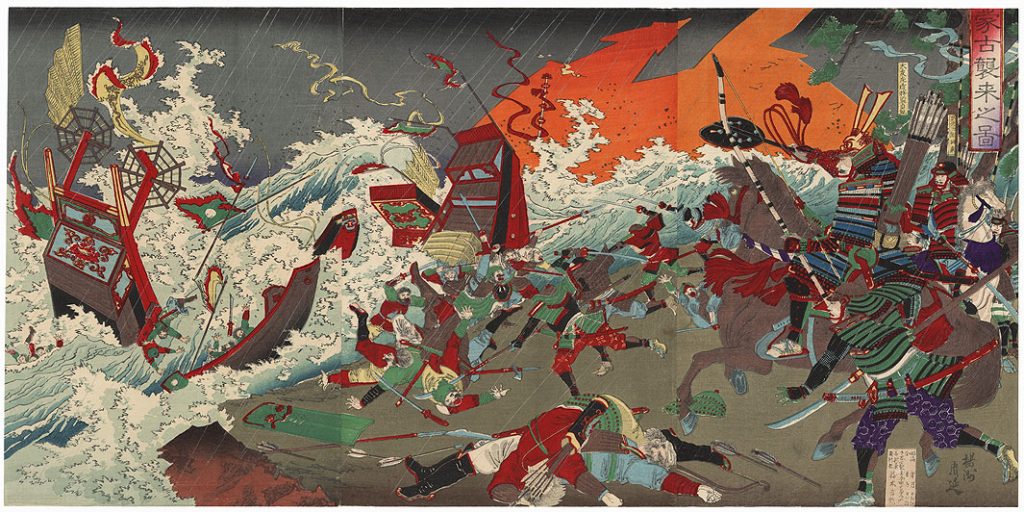
Japan and China have a long-intricate backstory, each with a unique and rich cultural history that spans thousands of years. Today, it seems like practically everything in the world is manufactured from one of these two economic powerhouses, but long before they began exporting anime, video games, Jackie Chan movies, and cheap knock-off products on Wish, these two nations were all but isolated from the rest of civilization, and for the most part, each other. Well, that is until that one time in 1274.
You see, during the 1200’s these two nations were under the rule of some of history’s most badass military forces: The Mongol Warriors of China’s Yuan Dynasty and the elite warrior caste of feudal Japan: the Samurai! It was at the later half of the Thirteenth Century when these two legendary warriors finally came into conflict with one another. Regardless of the outcome, it was sure to be a spectacular showdown that would echo through the halls of their ancestors, like the taunts of opposing football teams echoing through the locker rooms, right? Well, not exactly.
The Mongol Invasions of Japan would turn out to be one of the biggest Epic Fails in all of history… for both sides!
The Mongols Take China
Before we really get into it though, we need to set up some context, because there’s a lot to unpack here. Let’s rewind and give a little background on each of our combatants.
To start with, the Mongols were this group of hardcore warriors who first came together with the sole purpose of conquering the world (or at least Asia). They were a rambunctious horde of horse-back riding, arrow-shooting nomads who were first brought together, under the united banner of the Mongolian tribes, by a larger-than-life, butt-kicking fiend known as: Genghis Khan!

(Not to be confused with Kirk’s nemesis)
Between siring an astronomical number of heirs, Genghis Khan (read all about him here) conquered practically everything in sight. Whole villages would bow down before him, just because they’d heard rumors of the unpleasant alternative. He was even quoted as saying, “I am the scourge of God. Had you not created Great Sins, God would not have sent a punishment like ME upon you!” Modesty was not exactly his strong-suit. With an army of one-hundred-thousand, Genghis Khan took on the world, and won.

A drive-by-shooting, circa: Medieval China.
The empire he left behind eventually stretched from the Eastern Coast of Asia to Germany! That’s larger than any single country today! This Mongolian legacy was inherited down the line by Kublai Khan, the grandson of Genghis, who established what is known as the Yuan Dynasty of China. He also once met a guy named Marco Polo (for more on him check out my book “The Age of Exploration: Totally Getting Lost”).
Kublai Khan also decided to expand the Empire, like his grandpappy Genghis. Despite the Mongol’s success in conquering the Korean peninsula (under his father, Ögedei Khan), Kublai still had to contend with the old school Mongols who believed he’d become soft and claimed that they’d lost their warrior ways by adopting Chinese customs.
You see, the Mongols believed it was their destiny to conquer the world, so after hearing about this mysterious island of wealth off the coast of China (that was allegedly trading goods with their enemies, the Song Dynasty in the South), Kublai saw it as an opportunity to prove himself to his people. After all, the Mongols were basically the only ones in history to lead a successful assault on Russia in the middle of winter! So naturally they figured those islands off the coast of Korea shouldn’t be too much trouble, right? Right???
Meanwhile, in Japan…
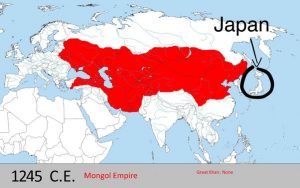
Around this same time, Feudal Japan was an interesting place to say the least. The only way I can think to describe it is a mix between the Wild West and a classic Akira Kurosawa movie. For much of its history, Japan was at war, with itself. Originally established as a government that closely resembled the Chinese, the Japanese soon began to culturally differentiate themselves from their neighbors across the bay, during the Heian period.
In 645 CE, a series of tax / land reformations were issued by the Japanese Emperor, a disastrous failure known as the Taika Reforms which inevitably backfired, and directly led to the land owners and farmers gaining more political power than the actual government. This gave rise to the Fujiwara Clan headed by Nakatomi no Kamatari from the capitol of Kyoto. The Fujiwara family ruled Japan until the 11th Century when public order evaporated like an ice cube in Death Valley and the islands soon fell into chaos.
Enter: the Samurai

The Samurai were armor-wearing martial artists with the single-coolest weapon ever created: The Katana, a super cool sword with a curved blade and elongated hilt. The lone, often nomadic, Samurai warriors answered to no one… well, except for the guy with the biggest check book. Wealthy landowners across Japan would hire armies of these Katana-sporting mercenaries to protect their property. (For more samurai lore, read my article on the 47 Rōnin!)
 Samurai were said to have lived by a code of honor known as Bushido, ‘The Way of the Warrior’ which was similar to that of the Knight’s code of Chivalry, with a Zen Buddhist twist. The Seven Virtues of Bushido are as follows: Rectitude, Courage, Benevolence, Respect, Honesty, Honor, and Loyalty. Above all else, their goal in life was to die an honorable death, a trait shared by their Nordic counterparts, the Vikings.
Samurai were said to have lived by a code of honor known as Bushido, ‘The Way of the Warrior’ which was similar to that of the Knight’s code of Chivalry, with a Zen Buddhist twist. The Seven Virtues of Bushido are as follows: Rectitude, Courage, Benevolence, Respect, Honesty, Honor, and Loyalty. Above all else, their goal in life was to die an honorable death, a trait shared by their Nordic counterparts, the Vikings.
The two most powerful clans of Japan at the time: the Taira and Minamoto clans, constantly vied for supremacy, often pitting their greatest warriors against one another in single-combat Thunderdome death battles. Eventually, in 1192, Minamoto Yoritomo emerged the victor. Minamoto established a new order: martial law enforced by the Shogun, military commanders of the Samurai forces.
Together, the Shogun and Samurai would maintain relative peace for the next 700 years…
Kublai Khan picks a fight
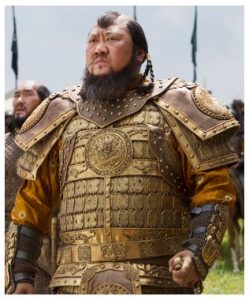
Kublai Khan (played by Benedict Wong on Netflix’s “Marco Polo”)
The year was 1266. While pillaging his way across the continent (the Mongols were still at war with the Song Dynasty in southern China at the time), Kublai Khan paused for a moment to insult the Japanese Emperor (Kameyama) before asking him to send a donation.
In his letter, Kublai Khan referred to himself as a god, and Emperor Kameyama as “the ruler of a small country” and advised him to pay tribute, or else. It was the 1200’s equivalent of a whiny internet troll demanding attention in the comments section of a You Tube video. What the Mongols didn’t realize is that at the time, Japan’s Emperor was more of a figurehead and that the real power resided in the Shogun, under the local regent, Hōjō Tokimune.
The Mongolian emissaries returned with no response (although I’m willing to bet the messengers simply didn’t want to repeat the real response to their kill-crazy despot’s face). Over the next six years, Khan sent *Five* separate notifications to the shores of Japan, and each time the Mongolian messengers were sent packing with nothing more than “the finger” in response to Kublai’s request.
Finally, after losing his patience, Kublai Khan basically said “That’s it!” and in 1272 he commissioned the construction of about 600 sea-faring attack-ships, drafted an army of 40,000 Mongols, Chinese, and Koreans over the next two years and prepared his armies for a full-scale invasion of Japan!
Mongol vs Samurai – Round One: Fight! (1274)

The Mongols were brutal and ferocious fighters, and they had an armada of ships that would embarrass the Greeks during the Siege of Troy. They set sail for the East, and got all pumped, cranking up the death metal tunes en route with their massive war drums. These stab-happy Mongolian warlords were all walk and no talk, that’s just how they rolled. These guys meant business.
The Samurai on the other hand were smooth operators: calm and efficient in everything from trimming a Bonsai tree to committing suicide when they failed. This ragtag group of honorable mercs knew they were hopelessly outnumbered, but thousands of samurai warriors answered the call, and geared up for the coming battle. Assembling along the shore of Hakata Bay, they wore elaborate armor and masks that were evocative of demons, striking fear into the hearts of their enemies – almost like a medieval Batman, and just like the Dark Knight, they were not to be trifled with! Unlike the Mongols though, the Samurai were primarily geared for one-on-one fights to the death, not unlike Mortal Kombat, except maybe less laser eyes, flaming skulls, and freeze powers.
On their way across the sea to Japan’s mainland from Korea, the Mongol warriors stopped by a few smaller islands along the coast and kicked their butts too, just because. One of those islands was Tsushima…
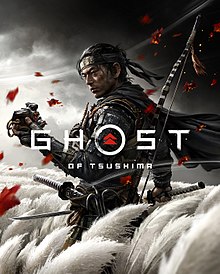
Yes, that Tsushima ^
“According to our manner of fighting, we must first call out by name someone from the enemy ranks, and then attack in single combat. But they (the Mongols) took no notice at all of such conventions; they rushed forward all together in a mass, grappling with any individuals they could catch and killing them.” – Hachiman Gudōkun
Here’s how I imagine this went down: When the Mongolian boats appear, a lone Samurai walks out onto the beach. He bows before the intimidating might of the mighty Khan’s forces, barely acknowledging the approaching war drums. This single warrior shouts above the roar of the tide, announcing his full name, title, and lineage, as is his time-honored custom. The brave Samurai is preparing for one-on-one combat, a tradition passed down through the ages by his ancestors. Halfway through listing his heritage, his face becomes a pin-cushion for a volley of arrows…

“Come at me Bro!”
Next, another brave samurai appears out of the bamboo woods, swearing to avenge his fallen master and openly challenging the entirety of the Mongolian invasion force, right before he too is obliterated. This probably went on a few more times until they came to the realization that the Mongols approached combat a little differently. Their form of combat would have been akin to an ant attempting to fight off a magnifying glass. This is of course an over-exaggeration, but the point is that the Mongols were a well-oiled machine when it came to the business of conquering, whereas most of the samurai at the time didn’t have a whole lot of experience with large-scale warfare and were much more equipped for skirmishes, or one-on-one death matches.
One lone samurai warrior, named Sukesada, allegedly managed to cut down 25 enemy soldiers in single combat! Despite their valiant resistance though, the Mongols made quick work of the samurai on the islands of Tsushima and Iki before sailing for mainland Japan…
The (first) Battle of Hakata Bay
On November 19th, 1274: the Khan’s armada was in sight of Hakata Bay, on the island of Kyushu (near Fukuoka, which sounds like a funny insult in English). The Shogun regent, Hōjō Tokimune (the true leader of Japan at the time) gathered up his forces and awaited the Mongol assault with a line of about 3,000 samurai cavalry and archers facing off against upwards of 40,000 battle-hardened Mongols!

The Samurai on horseback armed with their signature Yumi bows, made the first move, engaging the mighty Yuan fleet with a barrage of arrows. According to Japanese sources, the Mongols simply laughed in response to their short-range arrows. As the Mongolian war drums and gongs echoed across the bay, the loud noises spooked the Japanese horses causing some of them to panic and retreat!
Armed with ceramic “thunder crash” bombs (basically an ancient Chinese hand grenade), crossbows and poison-tipped arrows, the Mongols quickly broke through the sea wall and managed to burn down the nearby village of Hakata! This brutal onslaught would have decimated the first wave of samurai if it weren’t for last-minute reinforcements which allowed them to retreat and lick their wounds. During the chaos however, one of the Mongol generals, Liu Fuxiang, took an arrow to the face! To add insult to injury, he then had his horse stolen by a samurai!
The Divine Winds
After the initial battle, the remaining samurai said their prayers, kissed their families goodbye and prepared for a futile last stand against this unstoppable legion. However, fate had different plans in store.

Now as hardcore as the Mongols were, they were far more adept at fighting on land, and not so much at sea. Their naval inexperience turned out to be a huge liability. That very night prior to the armada’s landfall, a torrential downpour came over the bay. The Mongolian soldiers of the Great Yuan Fleet worried the incoming winds would crash their wooden ships against the rocks along the coast, so the commanders decided to set sail into the ocean and sit out the storm.
Unfortunately (for Khan’s men), weather forecasts weren’t exactly a thing back then. As a result, the entire armada ran smack dab into a massive typhoon!

48 hours after sailing into hurricane force winds, the Mongolian Fleet was completely and totally annihilated after taking a brutal smack down from Mother Nature herself. According to the Chinese account in ‘The History of Yuan’, “a great storm arose and many warships were dashed on the rocks and destroyed.” Several of their boats were beached from the storm, so the remaining samurai seized on the opportunity, capturing and executing the sailors.
Following their defeat at Hakata, the samurai army began preparations for a last stand against the invaders at Mizuki castle, but the attack never came. When the clouds cleared away, the Great Yuan Armada had vanished along with the storm. When all was said and done, it’s said that *One-Third* of the Mongol ships lay at the bottom of the bay! This devastating turn of events forced the Mongols to retreat back to China after just a single day of combat on the shores of Kyushu, all thanks to some wacky weather.

Divine intervention can be a bitch…
News of the fleet’s utter destruction soon reached the Yuan capital at Dadu (Beijing). Upon hearing the reports of their losses, Kublai Khan didn’t seem so much phased by the incalculable loss of life as he was preoccupied with the fact that his plans for world domination had been foiled by a freak storm. However, he seemed to take the news reasonably well considering he’d just lost a large-scale game of Battleship against a rain cloud. After silently brooding in contemplation, Khan dispatched a delegation of six Chinese diplomats to Japan, giving the Kamakura Emperor a choice: bow down before his might (in person), or be destroyed.
The Japanese response came in the form of six decapitated Chinese diplomats…

Kublai Khan contemplating his revenge.
A Seven Year Interlude
You would think that having just suffered a PR nightmare, Kublai Khan would keep his cool and not do anything brash in response to this hollow provocation. Instead the Mongolian Emperor decided to invest all his resources into crushing his new sworn enemy by any means necessary.
Over the next seven years the Mongolian forces regrouped, rebuilt, and rearmed a brand new and improved armada under a newly created government department: “The Ministry for Conquering Japan” (seriously!). This newly minted division of Mongolian bureaucrats drafted a two-pronged, ‘fail-proof’, plan of attack. Pleased with this, Kublai put his stamp of approval on it.
Following the fall of the Song Dynasty in 1279, another, even larger, fleet was commissioned with the sole purpose of crushing the Japanese resistance once and for all.
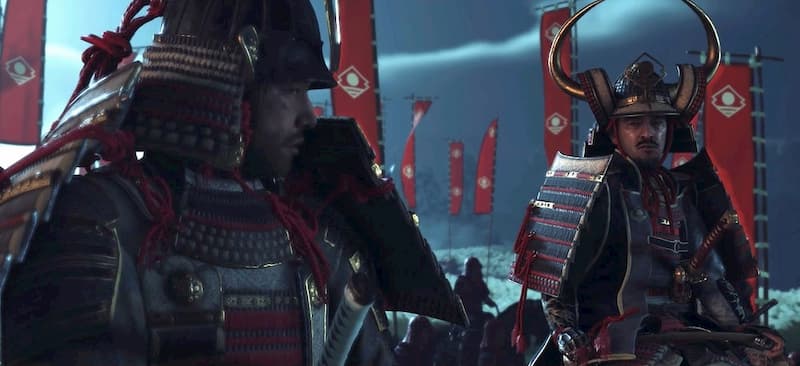
This time however, the Samurai had also been given a *Seven Year* window of prep time. During the interim, a 25 mile long, 15 foot high, defensive wall was built around the perimeter of Hakata Bay and there were now 40,000 samurai awaiting their dreaded enemy from the west. This time they were ready to kick some Mongolian beards in. This time it was personal.
The Mongolian Yuan army was also eagerly anticipating a quick end to this cursed campaign. There would indeed be a quick and decisive end, just not the way they had in mind.
Mongol vs Samurai – Round Two: Electric Boogaloo! (1281)
A whopping 140,000 Mongol warriors aboard 4,400 vessels set sail in two separate fleets from both Southern China and Korea! This is believed to be the largest single seaborn invasion in history, prior to 1944 at least. It was too big to fail, or so they thought. The mighty Southern Fleet originally intended to leave for Japan in the spring in order to avoid the dreaded typhoon season, but as Murphy’s Law would have it, they ran into a number of delays, including spoiled food, and one of the generals got sick, because of course.
The Korean fleet (about 900 ships) arrived at Hakata Bay on June 23rd, 1281. This time, they were surprised to find a militarized fortification in their path. The Chinese fleet was running late, so they decided to wait for reinforcements. The Great(er) Armada never arrived… (more on that later)
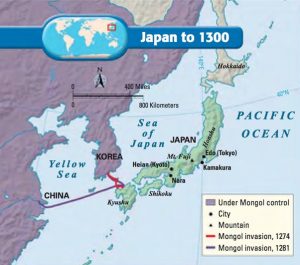
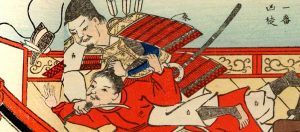
Over the next 50 days, while the Mongols awaited backup, a bunch of sneaky Samurai silently rowed out into the bay, under the cover of darkness. These Samurai black-ops would raid their ships, assassinate their soldiers, and then set their boats on fire for good measure. After committing naval arson, they quietly ninja-ed out and rowed back to shore before the remaining Mongolian commanders smelled smoke the next morning.
Meanwhile, out to sea… an even larger convoy approached on the 12th of August, 1281: 3,500 ships manned by more than 100,000 Mongolian soldiers! While the resilient samurai sharpened their katanas, the Shinto monks desperately prayed against all odds for a miracle. Funny thing is, their prayers were answered!
Three days later, this unprecedented Mongolian armada had Japan in its sights when they all started to hear the cracking of thunder over the bay. This is probably akin to what they saw in the distance:

“Uh… Um, guys? Is that what I think it is?!”

“Aw, hell nah! Not again!” – some random Mongolian sailor, probably
This even bigger, stronger attack force was met with something far deadlier: A SECOND TYPHOON!?
This wasn’t just any kind of storm either, this was the kind of storm that only occurred once every three hundred years or so and it just so happened to show up and rain on this Mongolian parade… once again. Seriously, what are the chances?
Relentless winds, torrential rain, and towering waves battered the ships into one another until they were nothing but splinters. The few Mongols unlucky enough to wash ashore were then greeted by Japanese steel. This swirling vortex of doom completely annihilated any potential chance the Mongols ever had of conquering Japan – a second time in a row!

The Japanese rejoiced from the shores as they watched this seemingly divine storm wipe out their enemies with ease. Over half of the fleet was decimated, most of the Southern Fleet was smashed against the rocky coastline of Kyushu. Between the ferocious storm and the angry samurai defending their homes a second time, only a handful of beat-up Mongols made it back alive to tell the tale.
Most of what we know about these invasions comes from a scroll scribed by a samurai by the name of Takezaki Suenaga, who survived both campaigns, barely. According to the Japanese, who had prayed to the Shinto God of War (Hachiman) for help, the gods had indeed shown up to aide them with Kamikaze, or “The Divine Winds”.
Unfortunately for the Kamakura bakufu (the Japanese government of the time), their treasury had already run dry between paying the veterans of the first invasion, and the Shinto priests who claimed responsibility for their miraculous victory, leaving the actual samurai soldiers who fought and bled for their emperor with nothing. This actually led to a 15 year civil war in 1318 when Go-Daigo seized power and the disgruntled samurai took his side, but that’s another story.
….Round 3?!

Following the Second (FAILED) Invasion of Japan, the Mongols had once again suffered monumental losses, in both sheer casualties and incomprehensible expenses. Not only that, but the notion of their perceived invincibility had been forever stained. All of these factors would eventually lead to the inevitable decline of Mongolian rule.
Kublai Khan could care less, even after this embarrassing defeat, he was completely and utterly determined to mount a *THIRD* invasion, regardless of the horrendous economic pitfall that they’d already fallen into. He began to plan for an even bigger assault! Go big or go home I guess?
However, as fate would have it, the Khan died before he could go through with it. His successors, who knew when to take a hint, unanimously decided to cancel the whole operation. Kublai Khan was followed by a series of incompetent rulers that were eventually replaced by the Ming Dynasty in 1368, which reigned over China until 1644, and the rest is history…
———-ERIK SLADER
Thanks for reading! If you’re a fan of the blog, be sure to listen to the Epik Fails of History podcast and check out my “EPIC FAILS” book series – available now on Amazon!

Check out my other articles here:
Qin Shi Huang Di – First Emperor of China
A Spartan’s Tale: Xerxes Fails
7 of the most Insane Viking Sagas Ever!
Sources:
“The Samurai: A New History of the Warrior Elite” by: Jonathan Clements
“Ghenko: The Mongol Invasion of Japan, 1274-81” by Nakaba Yamada
“The Mongol Warlords” by David Nicolle
https://www.ancient-origins.net/history-important-events/mongol-invasion-japan-0016974
http://asianhistory.about.com/od/japan/a/Mongolinvasion.htm
https://www.britannica.com/biography/Kublai-Khan
http://www.shmoop.com/news/2010/11/11/epic-fails-human-history/
http://www.japan-guide.com/e/e2127.html

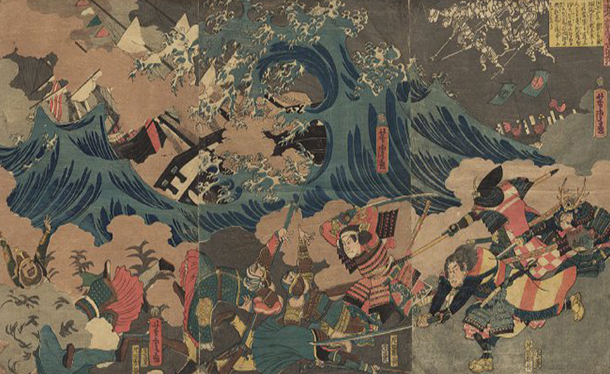

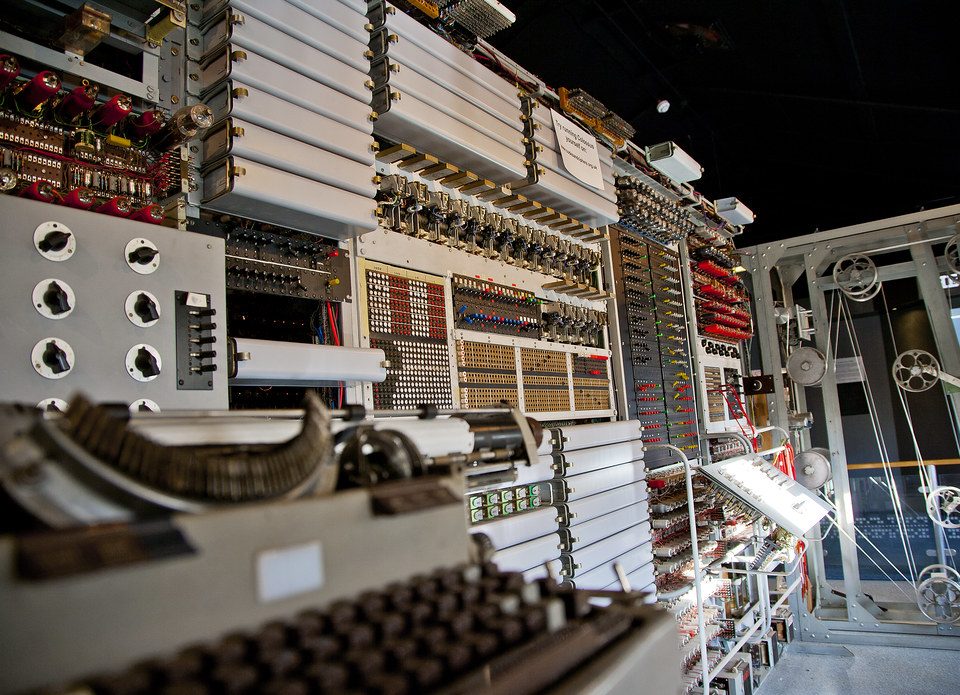
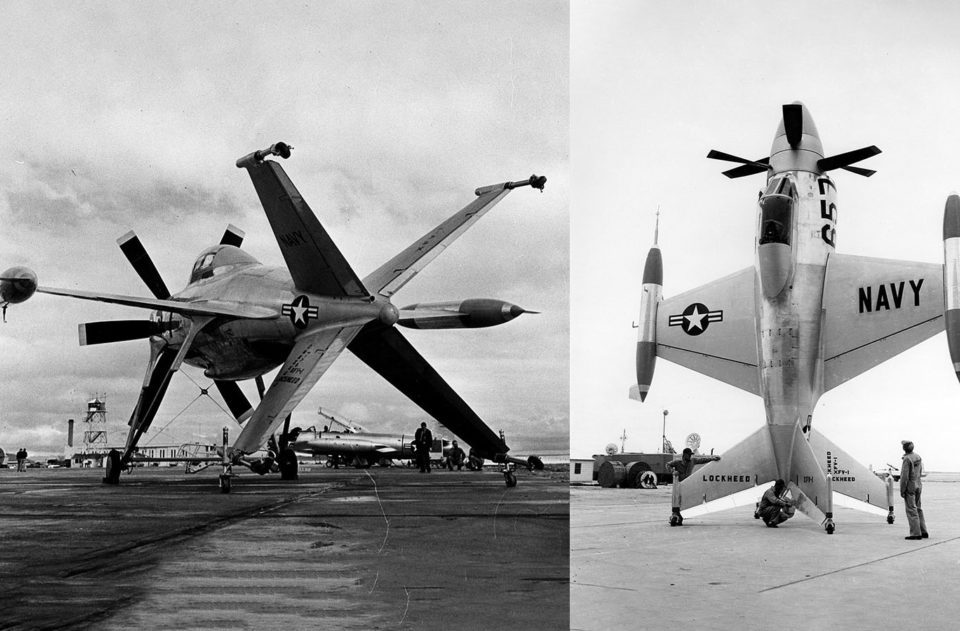
19 Comments
[…] —–Click Here for: THE MONGOL INVASION(s) OF JAPAN!! […]
[…] ———Be sure to Check out: “The Mongol Invasion(s) of Japan” […]
[…] Fail) are obvious candidates of Epic Failure, but others: the “Battle” of Karansebes, The Mongol Invasion(s) of Japan, and the Maginot Line, you may not have even heard of. In addition to brutal despots (such […]
[…] The Mongol Invasion(s) of Japan! […]
Reblogged this on EPiK FAILs!!.
[…] The Mongol Invasion(s) of Japan […]
[…] The Mongol Invasion(s) of Japan […]
[…] THE MONGOL INVASION(s) OF JAPAN […]
[…] THE MONGOL INVASION(s) OF JAPAN! […]
[…] THE MONGOL INVASION(s) OF JAPAN […]
[…] THE MONGOL INVASION(s) OF JAPAN […]
[…] Once I have a clear understanding of the subject matter, I begin working on the actual writing of the essay. During this phase, I usually focus on making sure it all makes sense. I especially love writing about events that lend themselves to vivid storytelling like The Mongol Invasion(s) of Japan. […]
[…] THE MONGOL INVASION(s) OF JAPAN […]
of course like your website but you need to take a look at the spelling on quite a few of your posts. Several of them are rife with spelling issues and I to find it very bothersome to inform the truth nevertheless Iˇll surely come back again.
Thank you for the feedback um… Birkenstock clogs for men…? Unfortunately I do not have an editor at this time, but feel free to let me know if you see something specific, or if you see a certain article that could use some more work. Thanks 😀
The Mongols are not Chinese….
Thank you so much for your reply Jc!
You are technically correct, I went back and did a little editing, hoping to clear that up (this is one of my earlier articles). While the Mongols had conquered and absorbed China, not all Mongols were Chinese. However, it’s worth noting that during this period, Kublai Khan was the Emperor of China’s Yuan Dynasty.
-Erik
[…] Click here to check out Erik’s original Epik Fails article! […]
[…] Click here to check out Erik’s original Epik Fails article! […]